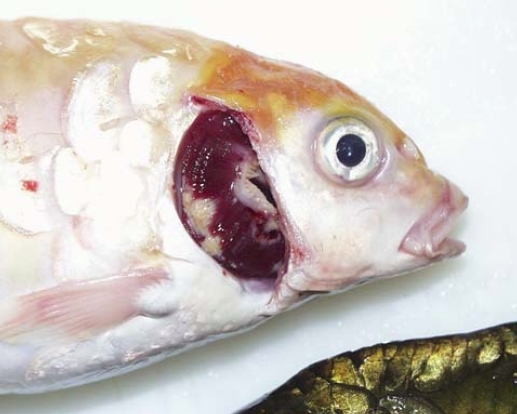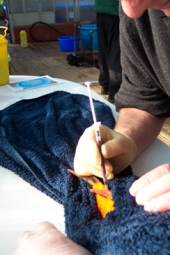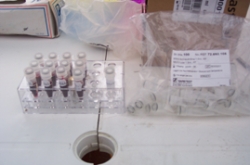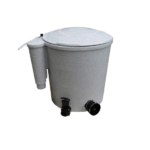Legal Obligation to Notify KHV Disease
- The Diseases of Fish (England and Wales) Order 2007 (SI 2007 No.864), which came into force on 6 April 2007, makes it a legal obligation to report suspicion that inland waters have become infected with KHV Disease.
- The Act sets out who should undertake the notification and the control measures for fisheries, other inland sites, fish farms, fish dealers and (fish) retailers. The Act also deals with Aquaria and Garden Ponds and we have set out brief details below.
What constitutes suspicion of KHV Disease?
DEFRA’s definition is: “Dead or dying fish with other clinical evidence such as bleeding from the gills, white patches on the gills or skin, sunken eyes and hyperactive behaviour in fisheries. These signs usually appear when water temperatures are between 15 o and 28 oC”.
However, these clinical signs in part can be associated with many other diseases therefore please do not panic if your Koi exhibits some of these features. Sunken eyes are not unusual with very sick fish which can be due to many causes.
Aquaria and Garden Ponds
- Hobbyists and other owners of ornamental fish should notify the Fish Health Inspectorate (FHI) of suspicion of infection with KHV Disease. The FHI will make a diagnosis on the basis of information provided about clinical signs of disease and assess the potential for the spread of infection.
- Where the spread of infection is assessed as negligible, no further action will be taken by the FHI. Site owners will instead be provided with written advice on the management of KHV Disease in aquaria and garden ponds.
- Where the assessment indicates potential for spread to inland waters, a sample will be taken for diagnostic purposes and, on confirmation of the disease, a cull of the affected fish and disinfection of the facility will be advised. If this is not feasible, a DAO will be placed on the site to prohibit the movement of fish on or off the site.
- Diagnostic testing on sites assessed as negligible risk will be available only on a commercial basis through Cefas Technology Ltd (CTL). (ie – you have to pay for it if you want it undertaken).
- Notification should be made to:
Fish Health Inspectorate
Cefas
The Nothe, Barrack Road
Weymouth
Dorset DT4 8UB
Tel: +44 (0) 1305 206600
Fax: +44 (0) 1305 206601
Email: fishhealthinspectorate@cefas.co.uk
Should anybody wish to read the full details of the Act, please contact us.
In looking at the Act in relation to hobbyist ponds, provided your pond is not connected to, or discharges into, an inland waterway, the spread of infection is assessed as negligible and no further action will be taken.
Should anybody have the slightest concern with regards to the possibility of KHV, please do not hesitate to contact us at any time and talk through any difficulties you may have. In most cases, the problems are likely to lie in other areas and can easily be remedied. We are more than pleased to make a follow up pond visit and if necessary, take samples for viral, bacterial and sensitivity testing. Lets make sure that it’s not some other problem before you contact the Fish Health Inspectorate.
History of KHV
- First known outbreak occurred in Israel Spring 1998
- Further outbreaks confirmed in Israel autumn 1998 & spring 1999
- In 1999, KHV was identified and published in mid 2000
- From 1998 onwards, outbreaks also recorded in all other continents.
- Extensive loss of carp in Japan (2003) and Indonesia (2004).
- Recent testing of stored histological samples has indicated an outbreak in the UK as far back as 1996.
KHV Recorded in:
|
Albania |
Macedonia |
Singapore |
|
Australia |
Indonesia |
South Africa |
|
Brazil |
Israel |
Sri Lanka |
|
Canada |
Jamaica |
Taiwan |
|
China |
Japan |
Thailand |
|
Columbia |
Malaysia |
Turkey |
|
Congo |
New Zealand |
UK |
|
Croatia |
Russia |
USA |
Spread of KHV in Japan
- First reported case October 2003.
- 23/ 47 Prefectures affected by the end of March 2004.
- 39/ 47 Prefectures affected by January 2005.
Where does a new virus come from?
- Its not new but around in the past.
- They are parasites (needs a host to survive) and normally found in small numbers causing little or no problem.
- Changing conditions can cause multiplication.
- Can jump one species to another (harmless to virulent).
- Geographic mixing of strains (harmless in one can cause disease in another i.e.. 1800’s – Western settlers in Africa & America.
How do my Fish get infected with KHV
- Direct contact with an affected fish.
- From fluids from infected fish.
- From water, mud and waste from infected systems.
- Depending upon water temperature, exposed fish may become infected and either:
- Become carriers of the virus.
- Develop the disease and die.
- Other non- susceptible Cyprinid (eg Goldfish etc.) do not appear to act as carriers.
Recognising the KHV Calling Cards
KHV should be considered if:
- Only Koi, Ghost and common varieties of carp are affected and killed all other species remain unaffected.
- Mortalities occur at water temperatures between 18- 30 deg.C. Mortalities slow down & stop outside this range.We believe you need a ‘stressor’ to trigger it.
- Mortalities are very rapid – healthy fish die within 24- 48 hours.
- Very high mortality rate – 80% to 100% can occur within 10 days of the disease outbreak
Significance of Temperature
- Most mortalities occur between 18 to 28 deg.C.
- There is virtually no occurrence at 30 deg.C. or above.
- The longer the water remains at 18 to 28 deg.C, the more likely that an outbreak will occur if the virus is present.
Clinical Signs of KHV (Uncertainty is the only certainty)
- Gill necrosis (gill disease and tissue die-back)
- Occasional nervous problems occur (inactivity followed by hyperactive behavior)
- Apply Rod & Gerry’s law – Ignore all the clinical signs given in academic papers and the technical press (sunken eyes, white patches, pale patches, bleeding gills) as they are not the ‘norm’ and only represent individual observations. –
- THESE WILL JUST CAUSE YOU INSOMNIA
- Look for the clinical symptoms of the prevailing bacterial pathogen.
Recognising Necrotic Gills

KHV Laboratory Testing (Two tests are currently available)
- Real Time Polymer Chain Reaction Test (PCR) This is currently the most accurate test available Involves the sacrifice of a (moribund) Koi.
- Elisa Test – This test can be undertaken without sacrificing your Koi It is a secondary test which detects antibodies – some aspects open to question but can give an overall indication using a 20% population sample.
- An on-site blood sample needs to be taken requiring a skill not practiced by most hobbyists. Specialist blood collection equipment is in place with HKL.
What happens if my Koi have KHV (several options)
- Cull the entire remaining stock, disinfect and re-stock again.
- Give your Koi to somebody who has a KHV positive stock.
- Retain your stock but your Koi and equipment must be kept secure from others. Heat treatment or antibiotic treatments (to hold secondary problems) may/ will help whilst antibodies develop.
- Some argue that fish surviving a KHV outbreak are naturally immune (or immunized) and hence useful. Others say that they could carry latent virus – assume the latter.
- Surviving fish should be regarded as potential carriers.
KHV Testing techniques:

Blood sampling
With the development of the ELISA (Enzyme Linked Immunosorbent Assay) test, a small blood sample is taken from live fish, which are anethised first. Koi which have been exposed to KHV or have been vaccinated will carry antibodies which, within a prescribed time frame, can be detected. If positive, the Koi will have the potential to transmit the virus to naive (previously unexposed) Koi and cause a disease outbreak in those fish.
In addition to this ‘standalone test’, there are many other tests available which looks at components in the blood sample and gives us a wider picture on recent exposures to any serious disease. With the advent of the new tests and improvements in intravenous blood sampling techniques, it is possible to test a fish for a virus without the need for culling, which predated methods used.

Sample Vials
In looking at bacteriology, all difficult systemic or ulcerated infections, and those which are having difficulties in healing, were previously sampled on the surface using a carrier swab. This was then sent to the pathology lab for bacteria identification and anti-biotic sensitivity testing. This method has its limitations. As it’s a ‘surface’ swab, you can also be sampling bacteria from the pond environment and not identifying the primary culprit. However, a blood sample can look for ‘deep seated’ internal pathogens which may be causing the infections, and the most effective antibiotic to use can be found more easily.
At Healthy Koi we firmly believe in the advantages of using blood sampling as a diagnostic tool and work to advance this area. As few in the UK undertake blood sampling at the present time, we donate surplus blood samples to the few UK laboratories who conduct viral research and to one which is currently developing a new KHV vaccine.
*Please note that intravenous blood sampling should not be carried out by the hobbyist but only by those with professional experience. Factors such as needle size, volume of blood removed, and the positioning of the needle are critical if you are not to injure your fish or cause unnecessary suffering.*


